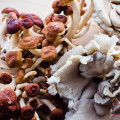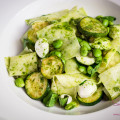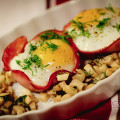 For Christmas, my sister-in-law gave me a copy of Plenty: Vibrant Recipes from London’s Ottolenghi by Yotam Ottolenghi. (OK, technically, this was a gift from my brother, too, but let’s be real; if you have a little brother, you know what I mean.) Plenty is a veggie-focused cookbook, although Chef Ottolenghi himself isn’t a vegetarian, so many of the dishes suggest adding a meat protein to serve alongside the veg dish. Great for us since while I’m trying to up the non-meat content in our diet, Shake isn’t crazy about the idea of completely vegetarian meals. I like that this gives me a way to bring the vegetables to the center of the dish instead of just serving a salad or a side of something green.
For Christmas, my sister-in-law gave me a copy of Plenty: Vibrant Recipes from London’s Ottolenghi by Yotam Ottolenghi. (OK, technically, this was a gift from my brother, too, but let’s be real; if you have a little brother, you know what I mean.) Plenty is a veggie-focused cookbook, although Chef Ottolenghi himself isn’t a vegetarian, so many of the dishes suggest adding a meat protein to serve alongside the veg dish. Great for us since while I’m trying to up the non-meat content in our diet, Shake isn’t crazy about the idea of completely vegetarian meals. I like that this gives me a way to bring the vegetables to the center of the dish instead of just serving a salad or a side of something green.
I started by flipping through the book, which has one of those padded covers I find irresistible — I like squishing things! — and marking potential recipes. As I expected, many asked for vegetables and grains that aren’t common here. In general, that doesn’t bother me since I’m not really in the habit of following recipes to a “T,” but since this is a Cooking From the Book post, here’s one I followed rigorously.
Reminder: Cooking From the Book posts are meant to be companions to the original recipe, not a substitute. As long as the book is still in print, I won’t be copying the recipe here for you. See here for why.
Before You Start (Regarding Ingredients)
I picked out this recipe — and made it — before Shake went on his mushrooming adventure; kind of a bummer because this would have been a perfect dish for his ‘shroom bounty. I did, however, use mushrooms from the same farm he visited — Hamakua Heritage Farm. I love their Ali‘i mushrooms and use them in pretty much everything. They’re meaty and have a great texture and taste. Ottolenghi’s recipe asks for “mixed wild mushrooms,” but I really don’t know where normal people get those, so the Ali‘is seemed like a very reasonable substitution. (I don’t know — does “wild” simply correlate to not-regular-white-button-or-portobella-mushrooms?) The store was out of the mix packages of Hamakua mushrooms that they usually have, so it was Ali‘i-only for us. I would definitely recommend trying to find an assortment, though, because it would make this dish so much more interesting.
It’s hard to tell which are the Ali‘i and which are the regular button mushrooms in this photo, I know. (The recipe asks for the run-of-the-mill mushrooms, too; presumably because “mixed wild mushrooms” are harder and more expensive to come by and mushrooms cook down so much so you need a lot — another reason why I like the Ali‘i variety; they retain their meatiness throughout the cooking process.) If you really want to know, the Ali‘i are the ones that look kind of old and discolored — they’re not; they just look that way.
Aside from finding some “exotic” mushrooms to use, the items in this recipe are rather easy to get your hands on. Baby potatoes are common, of course — I liked the idea of using multi-colored ones, especially since the recipe calls for using them skin-on.
These potatoes happened to be really “baby” — roughly the size of jumbo strawberries. I really should have used more than the 5 that the recipe called for. But I was following the directions!
 Ricard, Pernod or other anise-flavored liqueur— This is the one non-produce item you might not have in your kitchen. Ricard and Pernod are made by the same French company, Pernod Ricard. A list of other anise-flavored (i.e. licorice-y) liqueurs can be found here. The ones you’re most likely to maybe have lurking in your bar cabinet (or go find a cocktail-obsessed friend; they’ll probably have one of these, if not the Pernod): absinthe, Chartreuse, Galliano, ouzo or sambuca. If you’re into black licorice and experimenting with cocktails, invest in a bottle of absinthe or Chartreuse — you’ll find many interesting uses for it. (They’re not exactly cheap, but if you like the flavor, they’re fun to play with and we often come across cocktail recipes that ask for one or the other.)
Ricard, Pernod or other anise-flavored liqueur— This is the one non-produce item you might not have in your kitchen. Ricard and Pernod are made by the same French company, Pernod Ricard. A list of other anise-flavored (i.e. licorice-y) liqueurs can be found here. The ones you’re most likely to maybe have lurking in your bar cabinet (or go find a cocktail-obsessed friend; they’ll probably have one of these, if not the Pernod): absinthe, Chartreuse, Galliano, ouzo or sambuca. If you’re into black licorice and experimenting with cocktails, invest in a bottle of absinthe or Chartreuse — you’ll find many interesting uses for it. (They’re not exactly cheap, but if you like the flavor, they’re fun to play with and we often come across cocktail recipes that ask for one or the other.)
 The list of ingredients includes other items with licorice-y flavors, so if you’re not a fan…um, I don’t know what to tell you. (Actually, that’s not true; I do — choose your preferred fragrant herbs, like rosemary, sage and/or thyme, and a different liqueur, a dry sherry or white wine. I’m not the hugest fan of licorice myself, so normally, that’s what I would have done.)
The list of ingredients includes other items with licorice-y flavors, so if you’re not a fan…um, I don’t know what to tell you. (Actually, that’s not true; I do — choose your preferred fragrant herbs, like rosemary, sage and/or thyme, and a different liqueur, a dry sherry or white wine. I’m not the hugest fan of licorice myself, so normally, that’s what I would have done.)
Kitchen twine — definitely not hard to find; just don’t forget to get some! I did, but we have these silicone kitchen bands that I use for turkeys and chicken – a little awkward to use on these packets, but a lifesaver.
The Process
Super simple! If you can chop vegetables and mix, you’re golden.
Do be sure to cut off adequately large sheets of parchment. Don’t try and skimp to save — you run the risk of filling falling out or steam escaping during the cooking process.
The Results
This is a great side dish — easy to make, impressive when served. (Interactive dinner is always fun, and a wonderful fragrant cloud of steam wafts out when the diner opens up the packet). Ottolenghi suggests serving this “with a bowl of steamed white rice.”
That was a little too reminiscent of my days in college when I hated all the food the dining hall served and I lived on pasta with olive oil and dried herb seasonings, french fries and stir-fried rice with mushrooms snaked from the salad bar. So I served the parcels with some duck leg confit and crusty bread to sop up all the juices from the mushrooms and herbs.
Shake really loved the dish, and was especially enthused about the crusty bread soaked in the liquid at the bottom of the packets. I had a leftover packet for lunch the next day and the flavors had melded together wonderfully. (I ate it with a piece of leftover steak from another meal. Perfect.) It surprised me a little how much I enjoyed this dish because I don’t normally care much for the flavor of anise/black licorice. It’s quite delicate in this dish, though, and not overwhelming at all.
The Verdict
Should I try this recipe? Yes. As I said, it’s easy to make and you end up looking like quite the fancy cook with your little roasted packets. If you don’t want to go the vegetarian route, you can serve it as a side, like I did, or add some fish to the mix — a suggestion in the recipe opening notes from Ottolenghi. (He doesn’t specify what kind, but a white fish — snapper, marlin, mahi mahi — would be good, as opposed to ‘ahi or other dark or oily fishes.)
Difficulty: 2 out of 5
Should I buy the book? I have mixed feelings on it. I’ve made a few recipes — the subjects of future posts — and some I’ve followed closely, as I did this one, and others I just couldn’t stick with because I felt they were unnecessarily complicated. This review by CHOW is rather critical of the book. I haven’t tried the three recipes the author took issue with, so I can’t comment on her experiences. But I do agree that if you think that just because this book is all about vegetables, it’s healthy, you’ll be sadly mistaken. There’s quite a bit of cream, butter, fats and frying.
The judges at the Food52 Piglet Cookbook Contest were kinder to Plenty, and the book made it to the last round. However, they nearly uniformly had similar criticisms to the CHOW article — Ottolenghi’s recipes are not terribly precise (some of the directions are ambiguous and lack detail that would help a less-experienced cook). I noticed the same issues. In fact, before reading the CHOW piece, I had the same exact question: “Should the ‘crushed’ garlic be smashed, pressed, or minced?” I thought Piglet judge Gabrielle Hamilton had the best analysis of the book, and I agree with her — and pretty much all the other critiques — that the recipes in this book are probably best used as inspiration rather than strict prescriptions. (By the way, a lot of the reviewers talk about the grams-to-ounces UK vs. US conversions thing — don’t worry about it; there’s an American edition out that uses US kitchen measurements in cups and tablespoons. If you’re worried about that sort of thing, just make sure you get the right edition. The American one has a different cover and is the one I have.)
Ottolenghi notes in the Introduction that some readers of his vegetarian cooking column in The Guardian (the basis for the book) were offended that he wasn’t a vegetarian himself, and more so by his suggestions to serve dishes with meat. I definitely don’t have a problem with this, since my goal isn’t to introduce us to a vegetarian diet, just to bring more vegetables in our life in a creative manner. For this purpose, I think Plenty is a fully excellent resource.
All things considered, if you are not comfortable in the kitchen, you might want to save this book for when you have a better feel for how to assemble a dish on your own, since it seems to require a lot of judgement calls on whether to stick closely to the directions or go with your gut.
Plenty: Vibrant Recipes from London’s Ottolenghi
by Yotam Ottolenghi
Retail List Price: $35.00
288 pages, padded hardcover
Chronicle Books; American edition (March 2011)
ISBN: 978-1452101248













Leave a Comment